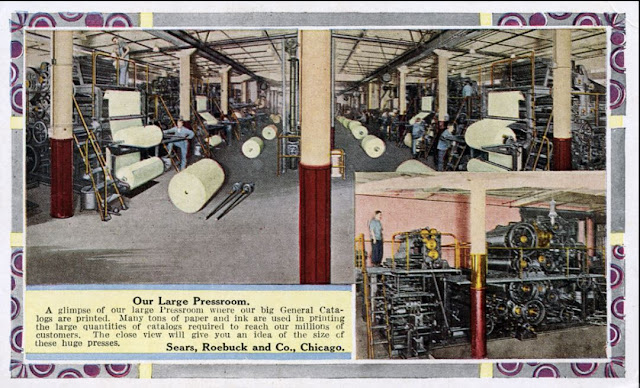 |
| A display area containing various items that can be purchased from the Sears catalog. |
It’s no secret that internet shopping on Amazon is causing
lackluster sales at department stores like Sears. There was a time, however,
when Sears Roebuck and Co. was one of the premier places to shop.
At about the turn of the century, Chicago-based Sears
Roebuck and Co. shipped most of its items to individuals using the mail system,
just like Amazon does these days. The only difference is that people ordered
the items from a catalog instead of through the internet.
Sears Roebuck and Co. also produced some really neat postcards
in the early 1900s to promote working for the company. Some of the postcard
images reminded me of television clips of Amazon employees working at distribution
centers. The postcards include images and text showing and describing work in the
shipping rooms and the in-house catalog printing and order processing departments.
 |
| Women working in the entry department placing customer orders onto tickets for the shipping department. |
These postcards have made me wonder if department stores
like Sears and Montgomery Ward wrote the rules for first showcasing goods
and then delivering them using the mail system. Sorry, Amazon!
Richard W. Sears moved his watch-selling business from
Minneapolis to Chicago in 1887 and hired watchmaker Alvah C. Roebuck to assist
him. The men sold their watch business in 1895 and started the mail-order firm. The company became successful very quickly and soon began to
surpass sales at Montgomery Ward.
Like Montgomery Ward, Sears printed thick catalogs for
customers and sold all sorts of items, from clothing to furniture to even kit
homes that you could build yourself. Many of these homes can be found today in west
suburban Berwyn and Downers Grove, among other places.
By 1906, the company had 9,000 employees with $50 million in
annual sales. The company, which was famous for its "no money down" credit policy,
pushed sales up to $235 million by 1924. It also began opening retail stores and
had 300 Sears stores across the country by 1929. It opened its flagship store on
State Street in Chicago in 1932.
By the 1970s, sales rose to $10 billion per year, and the
company decided to move its headquarters from a complex on Chicago's west side to the newly constructed world’s
tallest building, once named the Sears Tower. Soon after that, however,
discount stores like Kmart began competing with Sears and sales began to
decline.
 |
| Orders ready for freight shipment and workers using baskets to separate items. |
By the 1990s, the company began laying people off and moved its headquarters out of the tower to suburban Hoffman Estates. While some
Sears stores are still around today, the company filed for Chapter 11
bankruptcy in 2018, citing many reasons. Most conclude that Sears is failing
due to staunch competition with internet shopping companies like Amazon.
Like Montgomery Ward, Marshall Fields and even Kmart, the
big question now will be the future fate of Sears, a Chicago company that we
once thought would be around forever.
 |
| Workers weigh items to determine proper shipping costs. |
 |
| Workers use slides to help transport items from upper floors. |
 |
| Workers use huge printing presses to print out the Sears catalog for millions of customers. |
 |
| Workers enjoy a day of fun at an annual field gathering at the former Sears complex. |
 |
| The huge former Sears Roebuck & Co. complex in Chicago featured a water fountain and gardens near the entrance. |
 |
| Sears moved its headquarters to the Sears Tower after the building was constructed in the early 1970s and became the world's tallest building for a short time. |
I had no idea how well organized their system was! The postcards ( and of course your comments) tell the story really well. For me, Sears was always the go-to store for anything like an appliance, lawn mower etc. The name was practically synonymous with reliability and value. Thanks.
ReplyDelete